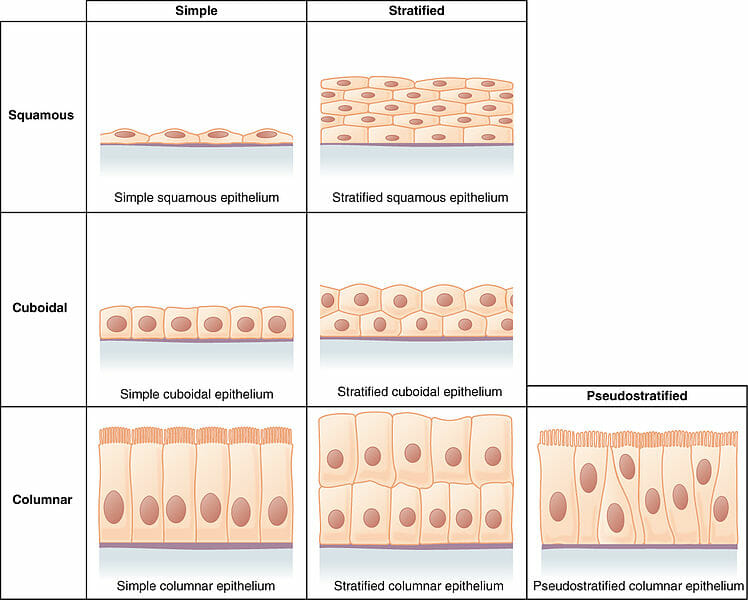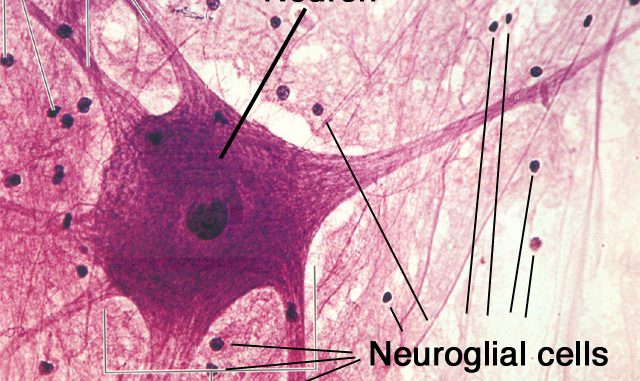ORGANIZATION IN HUMAN BODY
Levels of Organization
The living world can be organized into different levels. For
example, many individual organisms can be organized into the following levels:
- Cell: Basic unit of structure and function of all living things.
- Tissue: Group of cells of the same kind.
- Organ: Structure composed of one or more types of tissues. The tissues of an organ work together to perfume a specific function.Human organs include the brain, stomach, kidney, and liver. Plant organs include roots, stems, and leaves.
- System: Group of organs that work together to perform a certain function. Examples of organ systems in a human include the skeletal, nervous, and reproductive systems.
- Organism: Individual living thing that may be made up of one or more organ systems.
TISSUES IN HUMAN BODY
We will focused on the different types of tissues, and of what
type of cells are made up of:
Epithelial tissue
Functions of the Epithelium
In its role as an
interface tissue, epithelium accomplishes many functions, including:
- Protection for the underlying tissues
from radiation, desiccation, toxins, and physical trauma.
- Absorption of substances in the
digestive tract lining with distinct modifications.
- Regulation and excretion of chemicals
between the underlying tissues and the body cavity.
- The secretion of hormones into the blood
vascular system. The secretion of sweat, mucus, enzymes, and other
products that are delivered by ducts come from the glandular epithelium.
- The detection of sensation.
Characteristics of Epithelial Layers
Epithelial tissue is
composed of cells laid out in sheets with strong cell-to-cell attachments.
These protein connections hold the cells together to form a tightly connected
layer that is avascular but innervated in nature.
The epithelial cells
are nourished by substances diffusing from blood vessels in the underlying
connective tissue. One side of the epithelial cell is oriented towards the
surface of the tissue, body cavity, or external environment and the other
surface is joined to a basement membrane. The basement layer is non-cellular in
nature and helps to cement the epithelial tissue to the underlying structures.
Types of Epithelial Tissue
Epithelial tissue is classified based on the number of
cells, the shape of those cells, and the types of those cells.
*Simple squamous epithelium
Locations
|
Function
|
Air sacs of the lungs and the lining of the
heart, blood vessels and lymphatic vessels
|
Allows materials to pass through by diffusion and
filtration, and secretes lubricating substances
|
*Simple cuboidal epithelium
In ducts and secretory portions of small glands
and in kidney tubules
|
Secretes and absorbs
|
*Simple columnar epithelium
Ciliated tissues including the bronchi, uterine tubes,
and uterus; smooth (nonciliated tissues) are in the digestive tract
bladder
|
Absorbs; it also secretes mucous and enzymes.
|
*Pseudostratified columnar epithelium
Ciliated tissue lines the trachea and much of the upper
respiratory tract
|
Secrete mucous; ciliated tissue moves mucous
|
*Stratified squamous epithelium
Lines the esophagus, mouth, and vagina
|
Protects against abrasion
|
*Stratified cuboidal epithelium
Sweat glands, salivary glands, and mammary glands
|
Protective tissue
|
*Stratified columnar epithelium
The male urethra and the ducts of some glands.
|
Secretes and protects
|
*Transitional epithelium
Lines the bladder, urethra and ureters
|
Allows the urinary organs to expand and stretch
|
Connective tissue
Connective tissue
fibers provide support. Three types of fibers are found in connective tissue:
- Collagen
- Elastic fibers
- Reticular fibers
Collagen fibers are the strongest and most abundant of all the connective tissue fibers. Collagen
fibers are fibrous proteins and are secreted into the extracellular space and
they provide high tensile strength to the matrix.
Elastic fibers are long, thin fibers that form branching network in the extracellular
matrix. They help the connective tissue to stretch and recoil.
Reticular fibers are short, fine collagenous fibers that can branch extensively to form a
delicate network.
Functions of Connective Tissue
- Binding and supporting.
- Protecting.
- Insulating.
- Storing reserve fuel.
- Transporting substances within the body.
Loose Connective Tissue
In vertebrates, the most common type of connective tissue is
loose connective tissue. It holds organs in place and attaches
epithelial tissue to other underlying tissues. The three main types of loose connective fibers include
collagenous, elastic, and reticular fibers.
- Collagenous fibers are made of collagen and consist of bundles of fibrils that are coils of collagen molecules. These fibers help to strengthen connective tissue.
- Elastic fibers are made of the protein elastin and are stretchable. They help to give connective tissue elasticity.
- Reticular fibers join connective tissues to other tissues.
Loose connective tissues provide support, flexibility, and
strength required to support internal organs and structures such as blood
vessels, lymph vessels, and nerves.
Dense Connective Tissue
Another type of connective tissue is dense or fibrous
connective tissue, which can be found in tendons and ligaments. These
structures help attach muscles to bones and link bones together at joints.
Dense connective tissue is composed of large amounts of closely packed
collagenous fibers. In comparison to loose connective tissue, dense tissue has
a higher proportion of collagenous fibers to ground substance.
Dense connective tissue can be categorized into dense regular, dense irregular, and elastic connective tissues.
- Dense regular: Tendons and ligaments are examples of dense regular connective tissue.
- Dense irregular: Much of the dermis layer of the skin is composed of dense irregular connective tissue. The membrane capsule surrounding several organs is also dense irregular tissue.
- Elastic: These tissues enable stretching in structures such as arteries, vocal cords, the trachea, and bronchial tubes in the lungs.
Specialized forms
of connective tissue include:
Adipose
Adipose tissue is a form of loose connective tissue
that stores fat. Adipose lines organs and body cavities to protect organs
and insulate the body against heat loss. Adipose tissue also produces
endocrine hormones.
Cartilage
Cartilage is a form of fibrous connective tissue that is
composed of closely packed collagenous fibers in a rubbery gelatinous substance
called chondrin. The skeletons of sharks and human embryos are
composed of cartilage. Cartilage also provides flexible support for certain
structures in adult humans including the nose, trachea, and ears.
Bone
Bone is a type of mineralized connective tissue that
contains collagen and calcium phosphate, a mineral crystal. Calcium phosphate
gives bone its firmness.
Blood
Interestingly enough, blood is considered to be a
type of connective tissue. Even though it has a different function in
comparison to other connective tissues, it does have an extracellular matrix.
The matrix consists of the plasma with red blood cells, white blood
cells, and platelets suspended in the plasma.
Lymph
Lymph is another type of fluid connective tissue. This clear
fluid originates from blood plasma that exits blood vessels at capillary beds.
A component of the lymphatic system, lymph contains immune system cells
that protect the body against pathogens
Muscle tissue
Muscle tissue is essential for keeping the body
upright, allowing it to move, and even pumping blood and pushing food through
the digestive tract.
Muscle cells, often called muscle fibers, contain the
proteins actin and myosin, which allow them to contract. There are three main
types of muscle: skeletal muscle, cardiac muscle, and smooth muscle.
Smooth muscle cells do not have striations, while skeletal
muscle cells do.
Cardiac muscle cells
have striations, but, unlike the multinucleate skeletal cells, they have only
one nucleus. Cardiac muscle tissue also has intercalated discs, specialized
regions running along the plasma membrane that join adjacent cardiac muscle
cells and assist in passing an electrical impulse from cell to cell.
Skeletal muscle, which is also called striated muscle,
is what we refer to as muscle in everyday life. Skeletal muscle is attached to
bones by tendons, and it allows you to consciously control your movements. For
instance, the quads in your legs or biceps in your arms are skeletal muscle.
Cardiac muscle is found only in the walls of the
heart. Like skeletal muscle, cardiac muscle is striated, or striped. But it's
not under voluntary control, so—thankfully!—you don’t need to think about
making your heart beat. The individual fibers are connected by structures
called intercalated disks, which allow them to contract in sync.
Smooth muscle is found in the walls of blood
vessels, as well as in the walls of the digestive tract, the uterus, the
urinary bladder, and various other internal structures. Smooth muscle is not
striped, striated, and it's involuntary, not under conscious control.
Nervous tissue
Nervous tissue is involved in sensing stimuli and
processing and transmitting information. It consists of two main types of cells:
neurons and glia.
The neurons are the basic functional unit
of the nervous system. They generate electrical signals called conducted nerve
impulses or action potentials that allow the neurons to convey information very
rapidly across long distances. The glia mainly act to support
neuronal function.






Comentarios
Publicar un comentario